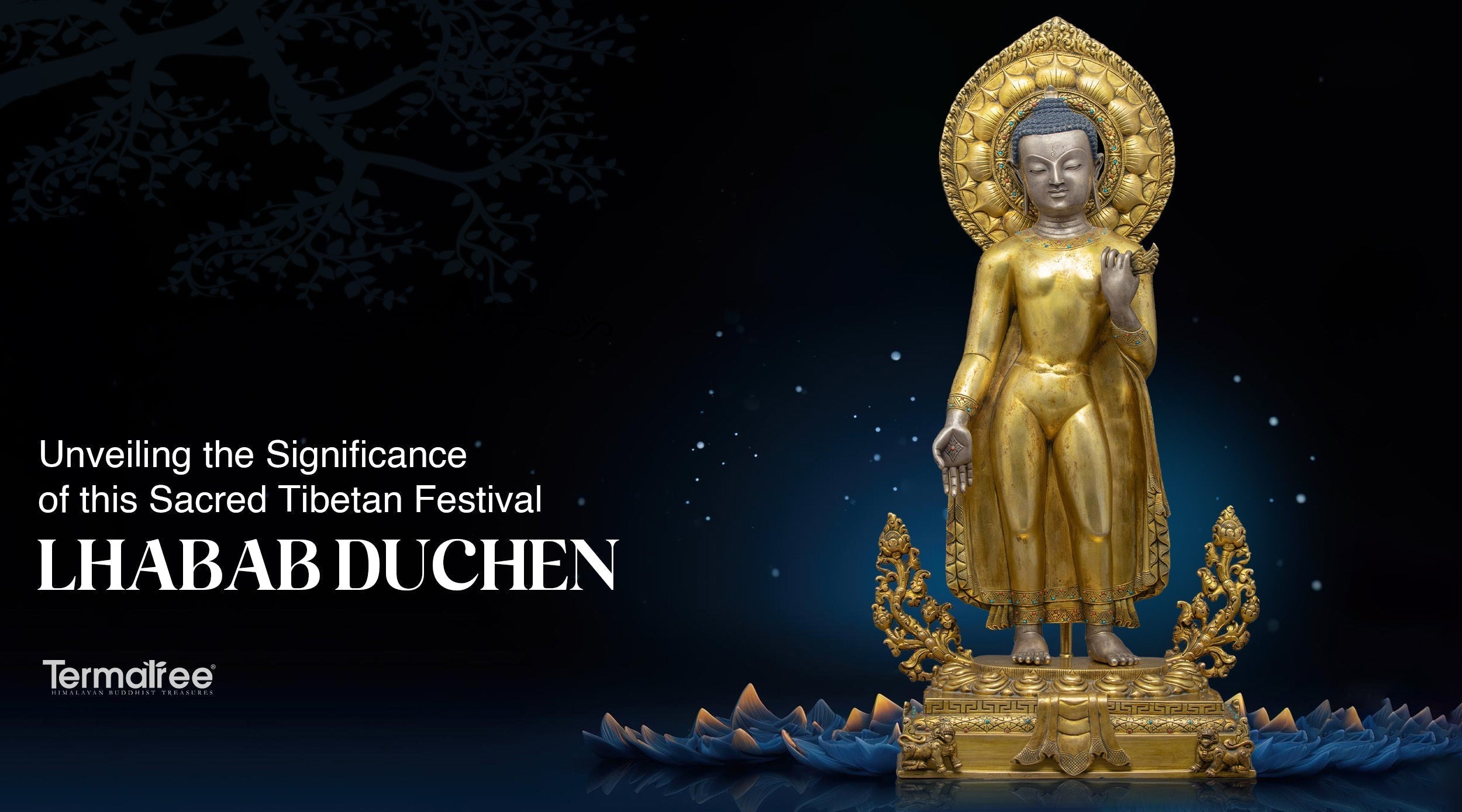A Glimpse into the Day of Buddha's Descent from Heaven
Lhabab Duchen, a significant date in the Buddhist calendar, provides practitioners with a unique opportunity to strengthen their dedication to the Buddha's wisdom. This day is rich with tales of extraordinary occurrences, serving as a poignant reminder of the Buddha's boundless compassion.
The term "Lhabab Duchen" derives from Tibetan, meaning "the grand event of divine descent," and it stands as one of the four principal sacred days in the Buddhist calendar, dedicated to honoring the life and teachings of the Buddha.
This is a festival commemorating the Buddha's second descent from heaven to earth. The first descent marked his birth, and the second was his return to earth after delivering teachings to both gods and his heavenly mother. The decision for his return was not taken lightly and required extensive deliberation, urged by his devoted followers.
The Historical Significance
-
The Buddha's Journey

Click here to view our Shakyamuni Buddha Statue
Lhabab Duchen's narrative unfolds with the Buddha's ascent to Trayastrimsa Heaven at the age of 41. During the summer retreat, after achieving enlightenment, Gautam Buddha discovered that his beloved mother, Mayadevi, who had passed away shortly after his birth, was now residing there.
Trayastimsa (33 Heaven), a realm populated by numerous gods, recognized that it was a place where desire still existed, making it impossible for mortals reborn there to attain liberation from samsara.
Driven by his deep desire to assist his late mother, the Buddha embarked on a journey to this heavenly realm. Over three months, he imparted profound teachings not only to his mother but also to the multitude of deities inhabiting that celestial domain.
Significant Events Leading to Lhabab Duchen
| Event | Description |
| Buddha's Ascent | It is believed that Buddha ascended to Trayastrimsa on the day of the full moon of the fourth lunar month. |
| Three months of teachings to his mother | |
| Descent to Earth | His return to earth is celebrated on the 22nd day of the ninth lunar month. |
- The Descent from Heaven
Upon completing his teachings, the Buddha descended to earth, specifically at Sankashya. The gods played a pivotal role in this event, crafting a remarkable triple ladder of gold, silver, and precious gems for his return. A gathering of humans and celestial beings witnessed this extraordinary descent.
Back on earth, the Buddha's disciples grew concerned about his prolonged absence, despite their awareness of his well-being in the 33 Heaven. They earnestly yearned for his return, with Maugalyayana, one of his dearest disciples, making a heartfelt plea.
The Buddha initially hesitated, leading to a protracted debate between the two. Ultimately, through persuasive dialogue, he was convinced to return to earth.
Seven days later, the Buddha descended the central of three stairways crafted from beryl, gold, and silver by Viswakarma, the god of machines, with Indra and Brahma, two prominent gods, descending alongside him down the other two stairways.
As he descended, the stairways began to fade, leaving only a small remaining section, around which Emperor Ashoka later constructed a temple.
The day of the Buddha's return, occurring on the 22nd day of the 9th month in the Tibetan calendar (which aligns with November 4th this year), is commemorated as Lhabab Duechen annually.
Significance in Buddhism
Lhabab Duchen is a crucial event, vividly showcasing the Buddha's boundless compassion and highlighting the profound connection between the terrestrial and celestial realms. It underscores the universal principle that enlightenment and the Buddha's teachings extend to all beings, transcending the boundaries of their existence.
Celebrations and Customs
- In Tibet
Tibetans hold Lhabab Duchen in deep reverence. Monasteries, nunneries and temples are embellished with vibrant decorations while laypeople actively participate in religious rituals like visiting sacred sites and presenting offerings.
Common Practices during Lhabab Duchen in Tibet:
| Activity | Description |
| Pilgrimages | Visits to sacred sites, monasteries, Stupas |
| Offerings | Presenting alms to monks and nuns |
| Prayers Flags | Hanging new prayers flags |
- Around the World
Globally, Buddhists celebrate this event according to their cultural traditions, often including processions, teachings, and community gatherings.
Religious Observances
During Lhabab Duchen, Buddhists partake in an array of religious practices, encompassing:
- Prayer and meditation sessions conducted in monasteries and homes.
- Attending teachings and reciting Buddhist scriptures.
- Offering tributes to the Buddha, Dharma, and Sangha.
Cultural traditions are also an integral facet of the celebration, featuring:
- Artistic performances that portray the life and teachings of the Buddha.
- The crafting of intricate sand mandalas and religious art.
Karmic Multiplication: Merit Accumulation
Lhabab Duchen is believed to magnify the consequences of positive and negative actions, making it an auspicious occasion for Buddhists to enhance their merit by engaging in virtuous deeds.
- Participation in virtuous activities is strongly encouraged on this day, including:
- Giving to charity and assisting the less fortunate.
- Performing acts of compassion like releasing animals or saving lives, known as tsethar.
- Practicing vegetarianism and refraining from harmful actions.
Monastic communities further partake in unique religious observances, which encompass fasting, extended meditation, and the recitation of sacred texts, as undertaken by monks and nuns.
| Monastic Activity | Purpose |
| Fasting | To purify the body and mind |
| Meditation | To cultivate inner peace and wisdom |
| Text Recitation | To honor the Buddha's teachings |
Lhabab Duchen in Modern Times
In today's context, Lhabab Duchen has become a day for communal engagement, emphasizing societal welfare. Activities such as charitable endeavors, promoting Buddhist awareness and engaging in interfaith dialogues have become prevalent.
"Lhabab Duchen 2023: 4th November"
In conclusion, this auspicious festival continues to serve as a potent symbol of the Buddha's teachings and his acts of compassion. Observing this day enables adherents to forge a deeper connection with the Buddhist path and instills inspiration to incorporate the values of benevolence and wisdom into their everyday existence.




